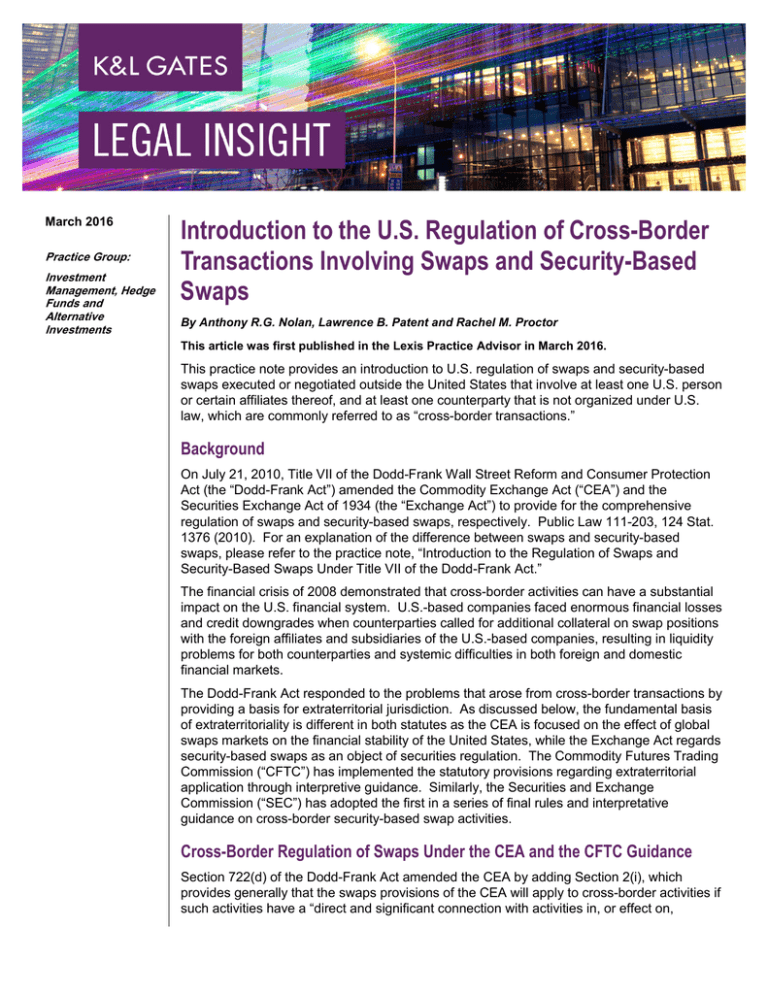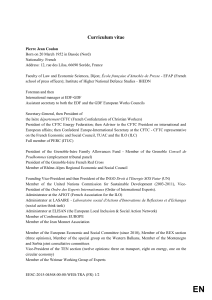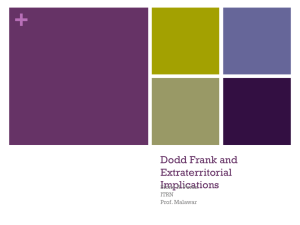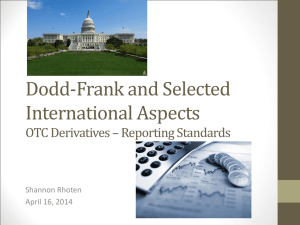
March 2016
Practice Group:
Investment
Management, Hedge
Funds and
Alternative
Investments
Introduction to the U.S. Regulation of Cross-Border
Transactions Involving Swaps and Security-Based
Swaps
By Anthony R.G. Nolan, Lawrence B. Patent and Rachel M. Proctor
This article was first published in the Lexis Practice Advisor in March 2016.
This practice note provides an introduction to U.S. regulation of swaps and security-based
swaps executed or negotiated outside the United States that involve at least one U.S. person
or certain affiliates thereof, and at least one counterparty that is not organized under U.S.
law, which are commonly referred to as “cross-border transactions.”
Background
On July 21, 2010, Title VII of the Dodd-Frank Wall Street Reform and Consumer Protection
Act (the “Dodd-Frank Act”) amended the Commodity Exchange Act (“CEA”) and the
Securities Exchange Act of 1934 (the “Exchange Act”) to provide for the comprehensive
regulation of swaps and security-based swaps, respectively. Public Law 111-203, 124 Stat.
1376 (2010). For an explanation of the difference between swaps and security-based
swaps, please refer to the practice note, “Introduction to the Regulation of Swaps and
Security-Based Swaps Under Title VII of the Dodd-Frank Act.”
The financial crisis of 2008 demonstrated that cross-border activities can have a substantial
impact on the U.S. financial system. U.S.-based companies faced enormous financial losses
and credit downgrades when counterparties called for additional collateral on swap positions
with the foreign affiliates and subsidiaries of the U.S.-based companies, resulting in liquidity
problems for both counterparties and systemic difficulties in both foreign and domestic
financial markets.
The Dodd-Frank Act responded to the problems that arose from cross-border transactions by
providing a basis for extraterritorial jurisdiction. As discussed below, the fundamental basis
of extraterritoriality is different in both statutes as the CEA is focused on the effect of global
swaps markets on the financial stability of the United States, while the Exchange Act regards
security-based swaps as an object of securities regulation. The Commodity Futures Trading
Commission (“CFTC”) has implemented the statutory provisions regarding extraterritorial
application through interpretive guidance. Similarly, the Securities and Exchange
Commission (“SEC”) has adopted the first in a series of final rules and interpretative
guidance on cross-border security-based swap activities.
Cross-Border Regulation of Swaps Under the CEA and the CFTC Guidance
Section 722(d) of the Dodd-Frank Act amended the CEA by adding Section 2(i), which
provides generally that the swaps provisions of the CEA will apply to cross-border activities if
such activities have a “direct and significant connection with activities in, or effect on,
Introduction to the U.S. Regulation of Cross-Border
Transactions Involving Swaps and Security-Based Swaps
commerce of the United States.” 7 U.S.C. §2(i). To address the scope of the Dodd-Frank
Act’s application in other jurisdictions, the CFTC has published guidance regarding how it
interprets that provision and regulations promulgated thereunder. 78 Fed. Reg. 45291 (July
26, 2013) (“CFTC Guidance”). According to the CFTC, this provision was intended to
address the perceived transfer of risk “across multinational affiliated entities . . . that make it
difficult for market participants and regulators to fully assess those risks.” CFTC Guidance at
45294.
The CFTC Guidance states that it is “intended to provide an efficient and flexible vehicle to
communicate the [CFTC’s] current views on how the Dodd-Frank Act swap requirements
would apply on a cross-border basis.” CFTC Guidance at 45297 n.39. Practitioners
generally are treating the pronouncements in the CFTC Guidance as if they were regulatory
provisions. The CFTC notes that it “will periodically review [the CFTC] Guidance in light of
future developments” and may adopt rules codifying certain aspects of the CFTC Guidance
in the future. CFTC Guidance at 45297 & n.39. The CFTC and the banking regulators have
already done that, as discussed below.
In 2013, the CFTC Guidance was challenged in a lawsuit filed in the District Court for the
District of Columbia alleging that the CFTC Guidance represented an improper rulemaking
that violated the Administrative Procedures Act (the “APA”). However, that challenge was
dismissed in 2014 on the grounds that the Guidance did not constitute a legislative rule
subject to the APA but rather was a nonbinding policy statement and interpretive rule outside
the protections of the APA. Sec. Indus. & Fin. Mkts. Ass’n., et al., v. CFTC, 13-CV-1916 slip
op. (D.D.C. Sept. 14, 2014).
U.S. Person
A key element of determining whether a particular transaction is subject to U.S. law requires
classification of the parties involved. Generally, at least one party must be a “U.S. Person”
or an affiliate thereof for U.S. law to apply. The CFTC Guidance sets forth a nonexclusive
list of persons that are considered a “U.S. Person” in this context:
1. Any natural person who is a resident of the United States;
2. An estate of a decedent who was a resident of the United States at the time of death;
3. Any corporation, partnership, limited liability company, business or trust association,
joint-stock company, fund or any form of enterprise similar to any of the foregoing (other
than an entity described in (4) or (5) below) (a “legal entity”), in each case that is
organized or incorporated under the laws of a state or other jurisdiction in the United
States or having its principal place of business in the United States;
4. A pension plan for the employees, officers or principals of such a legal entity, unless the
plan is primarily for the benefit of foreign employees of such entity;
5. Any trust governed by the laws of a state or other jurisdiction in the United States, if a
court within the United States is able to exercise primary jurisdiction over the
administration of the trust;
6. Any commodity pool, pooled account, investment fund, or other collective investment
vehicle that is not described in prong (3) and that is majority-owned by one or more
persons described in prongs (1)–(5), expect any commodity pool, pooled account,
2
Introduction to the U.S. Regulation of Cross-Border
Transactions Involving Swaps and Security-Based Swaps
investment fund, or other collective investment vehicle that is publicly offered only to nonU.S. persons and not offered to U.S. persons;
7. Any legal entity (other than a limited liability company, limited liability partnership or
similar entity where all of the owners of the entity have limited liability) that is directly or
indirectly majority-owned by one or more U.S. Persons described in (1)–(4) and in which
such person(s) bears unlimited responsibility for this obligations and liabilities of the legal
entity; and
8. Any individual account or joint account (discretionary or not) where the beneficial owner
(or one of the owners in the case of a joint account) is a U.S. Person described in (1)–
(7).
The CFTC expects that situations may arise where the list does not resolve a person’s
status. In such a case, the CFTC foresees utilizing a facts and circumstances test to
determine whether a person is a U.S. Person, taking into consideration:
i. the strength of the connections between the person’s swap-related activities and U.S.
commerce;
ii. the extent to which such activities are conducted in the United States;
iii. the importance to the United States of regulating such activities relative to other
jurisdictions where the person’s swap activities may take place;
iv. the likelihood that classifying the person as a “U.S. Person” could create regulatory
conflicts with another jurisdiction; and
v. considerations of international comity.
The CFTC also makes clear that the U.S. Person definition in the CFTC Guidance only
applies to swap regulation under Title VII of the Dodd-Frank Act and not to other CEA
provisions or regulations thereunder. CFTC Guidance at 45316.
One aspect of the U.S. Person definition that has created substantial controversy is the sixth
prong above, which addresses collective investment vehicles. Such a vehicle will be
classified as a U.S. Person in this context if a majority of the interests therein are owned by
investors that meet the other criteria of U.S. Person, even if the vehicle is organized under
non-U.S. law (such as the Cayman Islands) and managed by a non-U.S. manager (e.g., a
person operating from the United Kingdom). Using the ownership of a collective investment
vehicle to determine whether it is classified as a U.S. Person differs from the SEC definition
of U.S. person discussed below and other definitions of a U.S. Person adopted by the U.S.
Internal Revenue Service and even the CFTC itself in other portions of its regulations (see
CFTC Regulation 4.7(a)(1)(iv)).
To add to the confusion in this area, the banking regulators have adopted regulations to
govern margin on non-cleared swaps that focus only on where a collective investment
vehicle is organized (thus, a vehicle’s manager can be located in the United States and all of
the investors can be U.S. persons, but if it organized under Cayman law, it will not be
considered to be a U.S. Person for these purposes). 80 Fed. Reg. 74839, at 74883.
Under the CFTC’s proposed regulations that would govern margin on non-cleared swaps in a
cross-border transaction, the CFTC would not apply the majority-ownership test to a
collective investment vehicle for purposes of the “U.S. Person” definition, in a change from its
3
Introduction to the U.S. Regulation of Cross-Border
Transactions Involving Swaps and Security-Based Swaps
general cross-border guidance as discussed above, but it would retain the “principal place of
business” requirement for purposes of the “U.S. Person” definition. 80 Fed. Reg. 41376, at
41382-83 (July 14, 2015). As of the end of 2015, the CFTC had not yet adopted final
regulations to govern margin on non-cleared swaps in a cross-border transaction, so it
remains to be seen if the CFTC will be consistent with the banking regulators with respect to
the manager’s location. Investment fund managers should note that, for margin on noncleared swaps purposes, a non-U.S. branch of a U.S. bank swap dealer will be subject to
U.S. law with no availability for substituted compliance with the law of the jurisdiction where
the branch is located, which is another departure from the general CFTC guidance regarding
cross-border transactions.
Please see “U.S. Person Definition Comparison Chart: Regulation S, SEC Rule, and
CFTC Guidance” for a comparison of the definition of a U.S. Person under the SEC Rule
and the CFTC Guidance, with further comparison to the SEC’s Regulation S under the
Securities Act of 1933.
SD and MSP Registration Requirements
An entity whose swap-dealing activity exceeds the de minimis threshold (in the case of a
swap dealer (“SD”) or the major swap participant (“MSP”) calculation (in the case of a MSP))
must register as an SD or MSP, respectively, under the CEA. These registration
requirements apply not only to U.S. Persons, but also to non-U.S. Persons if the
counterparty is a U.S. Person or an affiliate guaranteed by a U.S. Person (with certain
exceptions, such as if the guarantor is a nonfinancial entity or the guaranteed affiliate is itself
registered as an SD). The CFTC Guidance in this respect differs from CFTC treatment
under Part 30 of its regulations of foreign intermediaries for futures and option transactions
made on behalf of US customers on or subject to the rules of a foreign board of trade, which
are not required to register under the CEA if registered with a foreign regulator. 17 C.F.R.
§30.10.
SDs and MSPs are subject to certain “Entity-Level Requirements” (as described below); SDs
and MSPs that are U.S. Persons or that transact with U.S. Persons in certain circumstances
are subject to “Transaction-Level Requirements” (as described below). SDs and MSPs that
are non-U.S. Persons may be able to satisfy certain of these requirements through
substituted compliance with their home country regulations, as described below.
Foreign Branch of a U.S. Bank SD
A “foreign branch” of a U.S. Person is considered to be a part of the U.S. Person. To be
classified as a foreign branch, the non-U.S. office must:
i. be subject to Regulation K, the Federal Deposit Insurance Corporation International
Banking Regulation or designated as a “foreign branch” by the U.S. bank’s primary
regulator;
ii. maintain accounts independently of the home office and other foreign branches with
profit or loss accrued at each branch determined as a separate item for each branch; and
iii. be subject to substantive regulation in banking or financing in the jurisdiction where the
foreign branch is located. CFTC Guidance at 45329.
4
Introduction to the U.S. Regulation of Cross-Border
Transactions Involving Swaps and Security-Based Swaps
The foreign branch of a U.S. Bank SD must comply with all Transaction-Level Requirements
(as discussed below) if the U.S. Person is a SD or MSP. However, acknowledging that
certain foreign entities may otherwise cease doing business with foreign branches of U.S.
Bank SDs to avoid application of the CEA, the CFTC Guidance permits foreign branches of
U.S. SDs that are banks to comply with their obligations under the Dodd-Frank Act through
substituted compliance with local law with regard to certain Transaction-Level Requirements
for swap trades between the foreign branch and the non-U.S. Person. Generally, the CFTC
would only permit substituted compliance where it finds local law to be comparable to U.S.
law.
Substituted compliance will only be permitted for required transactions between the foreign
branch and a non-U.S. Person. Generally, the CFTC would consider a swap to be with the
foreign branch and not the U.S. bank, when all of the following factors are present:
i. the employees negotiating the terms of the swap are located in the foreign branch;
ii. the foreign branch is the office through which the United States makes and receives
payments and delivers under the swap on behalf of the foreign branch pursuant to a
master netting or similar trading agreement, and the documentation of the swap certifies
that the office for the U.S. bank is such foreign branch;
iii. the swap is entered into by the foreign branch in its normal course of business;
iv. the swap is treated as a swap of the foreign branch for tax purposes; and
v. the swap is reflected in the local amounts of the foreign branch. CFTC Guidance at
45330.
Entry-Level Requirements and Transaction Requirements
As mentioned above, the CFTC Guidance divides the CEA’s swap provisions for SDs and
MSPs into two categories: “Entity-Level Requirements” and “Transaction-Level
Requirements.”
The Entity-Level Requirements apply to the entity as a whole because each requirement is
intended to provide that SDs and MSPs “maintain a comprehensive and robust system of
internal controls to ensure…the protection of the financial system.” CFTC Guidance at
45338. These include requirements related to:
i. capital adequacy,
ii. chief compliance officer,
iii. risk management,
iv. swap data recordkeeping,
v. SDR reporting, and
vi. physical commodity large swaps trader reporting.
The Entity-Level Requirements are divided into the “First Category” consisting of items (i)–
(iv) and the “Second Category” consisting of items (v)–(vi).
The Transaction-Level Requirements apply on a transaction-by-transaction basis and include
the following:
5
Introduction to the U.S. Regulation of Cross-Border
Transactions Involving Swaps and Security-Based Swaps
i. required clearing and swap processing,
ii. margining and segregation for non-cleared swaps,
iii. trade execution,
iv. swap-trading relationship documentation,
v. portfolio reconciliation and compression,
vi. real-time public reporting,
vii. trade confirmation,
viii. daily trading records, and
ix. external business conduct standards.
Similar to the Entry-Level Requirements, the Transaction-Level Requirements are divided
into two categories. The CFTC Guidance refers to items (i)–(viii) as “Category-A”
requirements, while item (ix), external business conduct standards, constitutes “Category B”
requirements.
Notwithstanding the above, if a U.S. Person is a party to a swap, generally the Dodd-Frank
Act requirements will apply without the availability of substituted compliance. The application
of certain categories of Entity-Level Requirements and Transaction-Level Requirements in
the context of substituted compliance for cross-border swaps is discussed below.
Substituted Compliance
As referred to above, the CFTC has articulated a “substituted compliance” regime whereby
the CFTC will allow certain non-U.S. SDs and MSPs to satisfy their Dodd-Frank Act
obligations by complying with the swap regulations of their home country. The CFTC has
identified the following jurisdictions as having regulations that may qualify for substituted
compliance: Australia, Canada, the European Union, Hong Kong, Japan, and Switzerland. If
the foreign branch is located in a jurisdiction other than the six listed in the preceding
sentence, the CFTC may still permit substituted compliance if the aggregate notional value of
all the swaps of the U.S. SD’s foreign branches in such other countries does not exceed 5
percent of the aggregate notional value of all of the swaps of the U.S. SD and the U.S. SD
maintains records (a) with supporting information for the 5 percent limit, and (b) to identify,
define, and address any significant risk that may arise from the non-application of the
Transaction-Level Requirements.
Non-SDs and Non-MSPs
Several of the CEA’s swap provisions and CFTC regulations apply to persons who are not
registered SDs or MSPs (“non-registrants”). Generally, a non-registrant is required to
comply with certain Entity-Level Requirements (such as SDR reporting), as well as certain
Transaction-Level Requirements (such as clearing). Unlike SDs/MSPs, the applicable
requirements for non-registrants are typically applied together or not at all. Persons that are
not financial entities, such as commercial end-users, may satisfy the clearing and exchange
execution requirements by claiming the clearing exception for hedging or risk-mitigating
transactions.
6
Introduction to the U.S. Regulation of Cross-Border
Transactions Involving Swaps and Security-Based Swaps
In a swap where one or both of the non-registrant counterparties is a U.S. Person, the
counterparties are required to comply with the non-registrant requirements; substituted
compliance is not permitted.
Cross-Border Application of the Dodd-Frank Act (referred to in this chart as
“DFA”) and the CFTC’s Swap Rules
U.S. Person
registered as
SD/MSP
Non-U.S.
Person
registered in
U.S. as an
SD/MSP
Other nonU.S. Person
not
guaranteed by
or conduit of
U.S. Person
Other nonU.S. Person
guaranteed by
or conduit of
U.S. Person
Foreign
branch of U.S.
bank that is a
U.S. SD
U.S. entity
DFA/CFTC
rules apply
DFA/CFTC
rules apply
Limited
DFA/CFTC
requirements
apply
Limited
DFA/CFTC
requirements
apply
DFA/CFTC
rules apply
Non-U.S.
affiliate
guaranteed
by or conduit
of U.S. entity
DFA/CFTC
rules apply
Category A
TransactionLevel
Requirements
apply, but
substituted
compliance
permitted
DFA/CFTC
rules do not
apply
Limited
DFA/CFTC
requirements
apply, but
substituted
compliance
permitted
Category A
TransactionLevel
Requirements
apply, but
substituted
compliance
permitted
Non-U.S.
affiliate not
guaranteed
by or conduit
of U.S. entity
DFA/CFTC
rules apply
DFA/CFTC
rules do not
apply
DFA/CFTC
rules do not
apply
DFA/CFTC
rules do not
apply
Category A
TransactionLevel
Requirements
apply, but
substituted
compliance
permitted
Factors that are relevant to the consideration of whether a non-U.S. Person is an ‘‘affiliate
conduit’’ include whether: the non-U.S. Person is majority-owned, directly or indirectly, by a
U.S. Person;
i. the non-U.S. Person controls, is controlled by, or is under common control with the U.S.
Person;
ii. the non-U.S. Person, in the regular course of business, engages in swaps with a nonU.S. third party(ies) for the purpose of hedging or mitigating risks faced by, or to take
positions on behalf of, its U.S. affiliate(s), and enters into offsetting swaps or other
arrangements with such U.S. affiliate(s) in order to transfer the risks and benefits of such
swaps with a third party(ies) to its U.S. affiliates; and
7
Introduction to the U.S. Regulation of Cross-Border
Transactions Involving Swaps and Security-Based Swaps
iii. the financial results of the non-U.S. Person are included in the consolidated financial
statements of the U.S. Person. Other facts and circumstances also may be relevant.
Cross-Border Regulation of Security-based Swaps Under the Exchange Act
and the SEC Cross-Border Rule
Section 30(c) of the Exchange Act, as added by Section 722(b) of the Dodd-Frank Act states
that no provision of the Exchange Act that was added by Title VII of the Dodd-Frank Act
“shall apply to any person insofar as such person transacts a business in security-based
swaps without the jurisdiction of the United States, unless such person transacts such
business in contravention of SEC rules promulgated to prevent evasion of any provision” of
the provisions added by Title VII. However, the Dodd-Frank Act also provides that no
provision thereof limits the SEC’s jurisdiction as in effect prior to the enactment of the DoddFrank Act.
The SEC adopted final rules and interpretative guidance to address the extraterritorial
application of U.S. securities laws to cross-border security-based swap activities (the “SEC
Rule”). The SEC Rule primarily focuses on the application of the definitions of “securitybased swap dealer” (“SBSD”) and “major security-based swap participant” (“MSBSP”) in the
cross-border context and the circumstances under which non-U.S. Persons may be required
to register as a SBSD or MSBSP. The SEC Rule is generally similar to the CFTC Guidance,
but does differ in some important respects. One important conceptual difference is that the
SEC Rule applies a territorial approach to the regulation of security-based swaps activity,
under which transactions by a non-U.S. Person with certain counterparties are considered to
have taken place in the United States regardless of where the activity actually occurred.
While perhaps a legal fiction in some circumstances, this approach reflects the more limited
extraterritorial reach of the Exchange Act over security-based swaps as compared to the
CEA over swaps.
U.S. Person
The SEC Rule defines the term “U.S. Person” to mean:
1. Any natural person who resides in the United States;
2. Any partnership, corporation, trust, investment vehicle or other legal person organized,
incorporated, or established under the laws of the United States or having its principal
place of business in the United States;
3. Any discretionary or non-discretionary account of a U.S. Person; or
4. Any estate of a decedent who was a resident of the United States at the time of death.
17 CFR 240.3a71-3(a)(4).
Foreign branches of U.S. Persons are generally considered U.S. Persons under this
definition. However, non-U.S. Persons are not required to count certain dealing transactions
conducted through a foreign branch of a U.S. bank towards the de minimis threshold or
computation amount that arise from transactions that are conducted entirely outside the
United States through a foreign branch of a U.S. bank that is registered as a security-based
8
Introduction to the U.S. Regulation of Cross-Border
Transactions Involving Swaps and Security-Based Swaps
swap dealer or that occur at least to 60 days prior to the effective date of final rules providing
for the registration of security-based swap dealers.
Please see “U.S. Person Definition Comparison Chart: Regulation S, SEC Rule, and CFTC
Guidance” to this practice note for a comparison of the definition of a U.S. Person under the
SEC Rule and the CFTC Guidance, with further comparison to the SEC’s Regulation S under
the Securities Act of 1933.
SBSD Registration Requirements
Under the SEC Rule, a non-U.S. Person (other than a conduit affiliate) that is engaged in
security-based swap dealing or other swaps-related activity may be subject to registration
with the SEC as a SBSD or MSBSP in whole or in part as a result of transactions with (i)
U.S. Persons and (ii) with non-U.S. Persons that are subject to recourse guarantees by U.S.
affiliates. The final rule permits non-U.S. Persons to exclude from the applicable de minimis
calculation certain positions that arise from transactions conducted entirely outside the
United States through a foreign branch of a U.S. bank that is registered as a SBSD. A nonU.S. Person that is a conduit affiliate of a U.S. Person must count all transactions against the
applicable de minimis exception. A “conduit affiliate” is a non-U.S. affiliate that enters into
security-based swaps with non-U.S. Persons or with certain foreign branches of a U.S. bank
on behalf of its U.S. affiliates and enters into offsetting transactions with its U.S. affiliates to
transfer the risks and benefits of those security-based swaps.
Substituted Compliance
Unlike the CFTC, the SEC did not identify certain jurisdictions that may qualify for substituted
compliance. Instead, the SEC adopted a procedural rule for entities to request a substituted
compliance order under the Exchange Act.
Authors:
Anthony R.G. Nolan
Lawrence B. Patent
Rachel M. Proctor
anthony.nolan@klgates.com
+1 212 536 4843
lawrence.patent@klgates.com
+1 202 778 9219
rachel.proctor@klgates.com
+1 503 226 5787
9
Introduction to the U.S. Regulation of Cross-Border
Transactions Involving Swaps and Security-Based Swaps
Anchorage
Austin
Fort Worth
Frankfurt
Orange County
Beijing
Berlin
Harrisburg
Palo Alto
Paris
Boston
Hong Kong
Perth
Brisbane
Houston
Pittsburgh
Brussels
London
Portland
Charleston
Los Angeles
Raleigh
Charlotte
Melbourne
Research Triangle Park
Chicago
Miami
Dallas
Milan
San Francisco
Doha
Newark
Dubai
New York
São Paulo
Seattle
Seoul Shanghai Singapore Sydney Taipei Tokyo Warsaw Washington, D.C. Wilmington
K&L Gates comprises approximately 2,000 lawyers globally who practice in fully integrated offices located on five
continents. The firm represents leading multinational corporations, growth and middle-market companies, capital
markets participants and entrepreneurs in every major industry group as well as public sector entities, educational
institutions, philanthropic organizations and individuals. For more information about K&L Gates or its locations,
practices and registrations, visit www.klgates.com.
This publication is for informational purposes and does not contain or convey legal advice. The information herein should not be used or relied upon in
regard to any particular facts or circumstances without first consulting a lawyer.
© 2016 K&L Gates LLP. All Rights Reserved.
10





